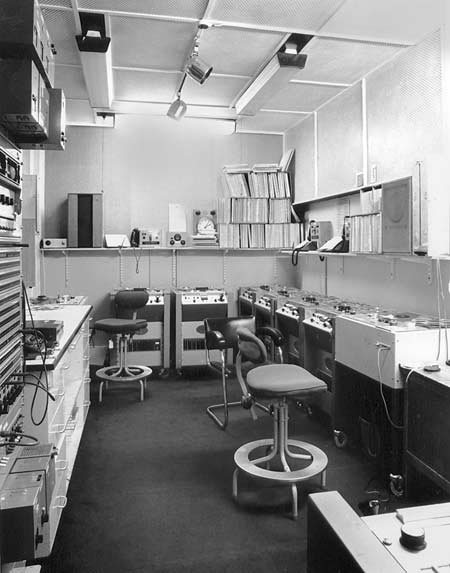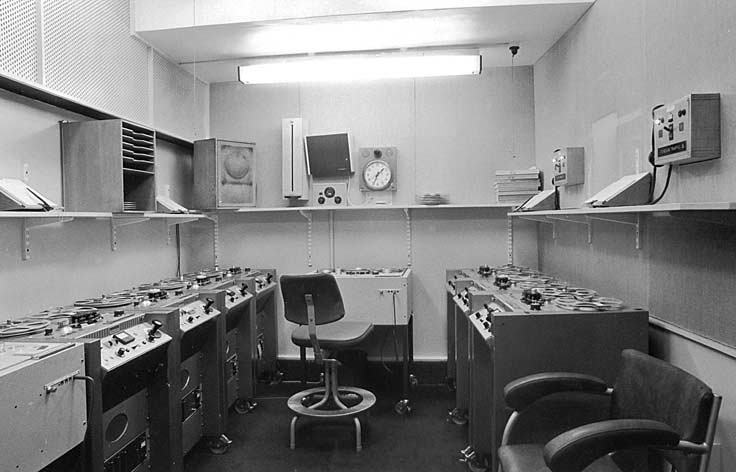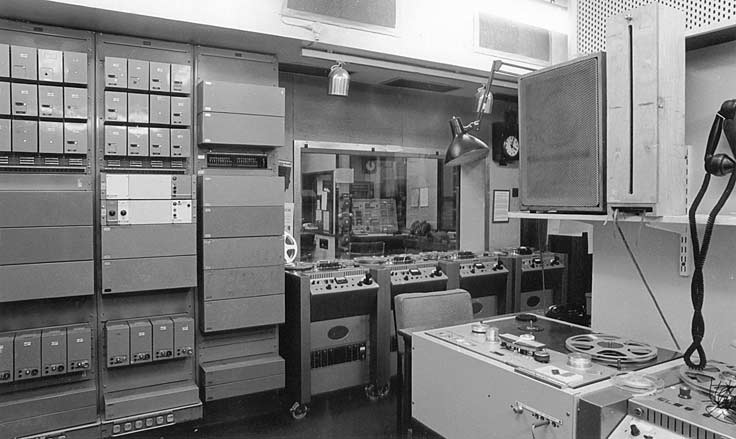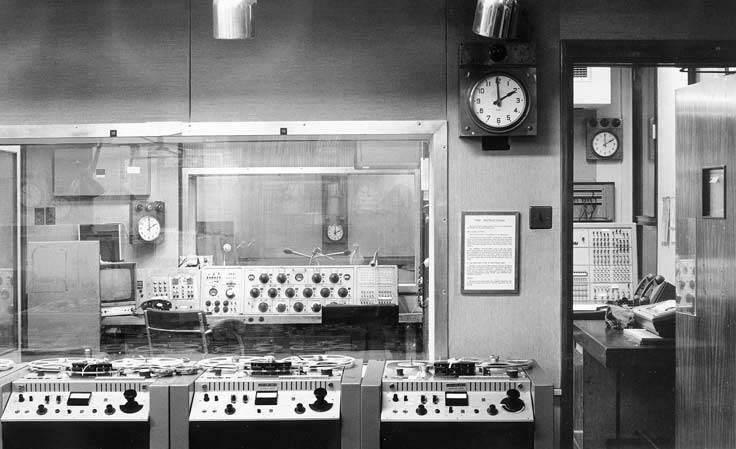
Jargon (used below)
ROT - a recording of a programme made at the time
of transmission.

We've turned to our right after entering H30 and are looking towards the main door to the corridor. The four machines to the right were used for ROTs and for remote recording from local news studios. One was used, for example, to back-up all recordings made in 3B. Tapes ready for various news outlets were placed in the six compartment box by the door ready for collection.

The bay provided a few dubbing amps and an equaliser. On the bench are a cassette player (of very dubious quality) a Uher (providing half-track dubbing) and a Ferrograph with a varispeed facility. A Presto disk channel originally stood here but not for long. The storage unit held a stock of NAB reels of tape; all the news studios drew on this supply for recording inserts. The drawers held spools and other supplies. The main store, though, was in a small room (or large cupboard) attached to studio 3A. By this time 3A was equipped as a standby newsroom. The storeroom formerly housed the apparatus cabinet for the studio.

Here should be eight Leevers for the Foreign News Traffic positions. One machine is missing. The traffic managers started the machines remotely and rang up afterwards with the details - contributor's name, tape number and any editing requirements. They had, of course, no indication of how much tape was left on their machines, and had to check with H30 before making lengthy recordings. As the number of news outlets increased, it became necessary to record most dispatches in duplicate so the SMs had to work swiftly to get the recordings off and the machines re-laced. Also in this part of the room were the remaining two M15As used for editing.

Standing within the previous picture, and looking back, we see the bays carrying power supplies, amplifiers and relay panels for 3B. A Type B desk didn't have much in it apart from faders. The M15A editing set-up shows that these machines each had a speaker attached. For much of this H30's life, producers were not supposed to physically edit their own tapes, but worked with an SM. This obviously meant using speakers and when all four editing machines were in use, the room became rather noisy! Originally a couple of Leevers were supplied for editing but these quickly turned into Philips "procured" from elsewhere. When the M15As arrived they were immediately liked by almost everyone.
The wooden box next to the loudspeaker is a dispenser for 5 inch spools. The originals had been made of cardboard. A good example of how, if you can get things into the system, they automatically get upgraded. The task of making up the spools with a length of red trailer and filling the dispensers was not a popular one, however, and was usually a group effort during the early morning shifts. In later days, the increasing number of recordings often required the dispensers to be topped up later in the day.
The final transmission from 3B was 'PM' on 5th June, 1981. The whole area was redeveloped in the following months. The functions of H30 were moved into the old 3A studio for the duration of the work. The site occupied by H30 became 3B studio and a new backup studio, 3K, was built in the old 3B studio space. A new H30 was built onto the back of BH in a small extension. WATO and PM continued to come from this area until the move to the News Centre at Television Centre. The 'new' 3B and H30 have now followed their predecessors into oblivion.
Nick Ross remembers H30
For some of the most formative years of my life H30 was the centre of the
known universe. We reporters were despatched from the World at One offices,
just across the third-floor corridor, and would return with stories to be
broadcast from the adjoining studio, 3B; but the heart of the operation, the
backroom mission control was H30. This is where our Uhers disgorged their
contents from plastic spools to industrial-scale metal ones to the whirr of
motors and the flap, flap, flap of flailing tape as the transfer was complete.
This is where, with a slice of Ever Ready Corrux single-sided razor blades,
we split rambling interviews into disjointed ribbons of magnetic tape and
spliced them into dialogue which - whether or not it precisely matched what
the speaker had intended - made for a coherent narrative. H30 was where, with
reporter and SM swaddled in black plastic headphones, we raced through sections
of recording we wanted to discard, so the speech became frenzied and comically
high-pitched and then dropped to impossible baritones as we braked to find
our edit points.This is where I learned to de-um and de-err speech and cut on the breath pause, the consonant or glottal stop to disguise the edit; skills which are often sadly lacking in TV. This is where I learned how to be manic and calm at the same time. This is where an inexperienced and sluggish SM could drive you mad with frustration, and where a good SM and competent reporter could efficiently marry a story together like a well-oiled machine.
H30 was the frenzied backroom in the hour before transmission and was often even more frantic as the programme went on air, with producers racing in or out with precious bobbins which had to be laced through the guides and across the heads then hurriedly spooled to the splice where the yellow leader tape gave way to magnetic brown.
On occasions the communications between producer and SM broke down. Once the SM had been thrown a tape to quickly 'top and tail', without being told there was a false start to the interview. It had been an unfortunate opening to a debate in which the programme's main presenter had missed the point and sounded embarrassingly foolish. When the finished piece was handed back, snapped into the player and spooled out onto the airwaves, listeners heard the discussion grind to a halt and the interviewees burst into laughter. The SM rushed to close the fader, and the harassed producer called on talk-back for the presenter to apologise and make time for them to wind on to the right start of the item. But when the studio microphone was opened all we heard was a dull thud, thud, thud. The presenter, mortified, had taken off his headphones, risen from the table, and was banging his head against the wall.
H30 was also the sanctuary where we could hide away, especially before Christmas, and put together some deeply inappropriate (and, with hindsight, probably very childish) recordings for the office party. It was certainly the room which helped to launch the career of the SM who rose to become Director of Radio. It was where talent was spotted in every sense, and it was the hotbed which sometimes led to other beds and unprofessional liaisons. Presumably it must have been the meeting place which led to marriage from time to time.
Jargon
P as B: Programme as Broadcast - a typed document
which recorded details of the programme - items used, contributors, durations,
etc.
Ah, halcyon days.

A final view from H30 back into 3B. A scene that anyone who worked in the area will be sure to remember.

